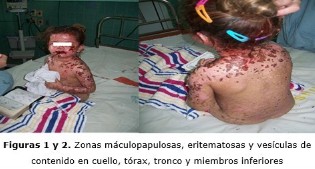Ectodermosis erosiva plurioficialis, un evento adverso inesperado de la fenitoína: presentación de un caso
Abstract
Fundamento: la ectodermosis erosiva pluriorificial también conocida como el síndrome de Stevens Johnson, forma menor de la necrosis epidérmica tóxica, es una enfermedad grave, típica, secundaria a medicamentos y en un menorporciento relacionada a infecciones.
Objetivo: fundamentar la necesidad del diagnóstico y tratamiento oportuno de la ectodermosis erosiva pluriorificialis, ante su aparición como evento adverso grave inesperado al uso de la fenitoína oral.
Caso clínico: paciente femenina de seis años de edad que manifestó esta enfermedad con un compromiso del 10 % de su superficie corporal. Ingresa con manifestaciones de inestabilidad hemodinámica en la unidad de cuidados intensivos del Hospital Pediátrico Universitario Dr. Eduardo Agramonte Piña de la provincia de Camagüey, se le diagnostica una ectodermosis erosiva pluriorificialis como una reacción adversa grave relacionada a la administración de fenitoína oral. El tratamiento se enmarca en la suspensión del medicamento, se trata con antibiótico endovenoso de amplio espectro, así como, la cura local para las lesiones de piel y mucosas. Es egresada con una evolución favorable y sin secuelas luego de 25 días de estadía.
Conclusiones: la ectodermosis erosiva pluriorificialis fue una reacción adversa grave relacionada con el uso de fenitoina, de ahí la importancia del diagnóstico oportuno y su tratamiento.
DeCS: SÍNDROME DE STEVENS-JOHNSON/diagnóstico; EFECTOS COLATERALES Y REACCIONES ADVERSAS RELACIONADOS CON MEDICAMENTOS; FENITOÍNA/efectos adversos; NIÑO; INFORMES DE CASOS.
Downloads
References
1.Ghirlinzoni C, Cruz FF, Costa E. Reações cutâneas a drogas em pacientes internados: relato de uma série de casos identificados pela farmacovigilância. Rev Bras Alerg Imunopatol [Internet]. 2012 [citado 12 Abr 2016];35(1):[aprox. 9 p.]. Disponible en: https://issuu.com/associacaopaulistamedicina/docs/rdt_v20n1
2.Weinand C, Xu W, Perbix W, Lefering R, Maegele M, Rathert M, et al. 27 years of a single burn centre experience with Stevens–Johnson syndrome and toxic epidermal necrolysis: Analysis of mortality risk for causative agents. Burns. 2013;39(7):1449-55.
3.Donizeti MJ, Torriceli SJ, Felipe TC, Ometto SH. Necrólise epidérmica tóxica/síndrome de Stevens-Johnson: emergencia em dermatologia pediátrica. Diagn Tratamento [Internet]. 2015 [citado 12 Abr 2016];20(1):[aprox. 6 p.]. Disponible en: https://issuu.com/associacaopaulistamedicina/docs/rdt_v20n1
4.Mirkamali A, Ingen Housz Oro S, Valeyrie Allanore L. Dermatological emergencies: a comparative study of activity in 2000 and 2010. J Eur Acad Dermatol Venereol. 2013;27:916-918.
5.Su S, Chung W. Update on pathobiology in Stevens-Johnson syndrome and toxic epidermal necrolysis. Dermatologica Sinica. 2013;31(4):175-80.
6.Barbosa-Moreno L, Salas-Alanís J, Ocampo Garza, J, Ocampo Candiani J. Urgencias dermatológicas. Dermatol Rev Mex [Internet]. 2015 [citado 12 Abr 2016];59(1):[aprox. 12 p.]. Disponible en: http://www.medigraphic.com/pdfs/derrevmex/rmd-2015/rmd151e.pdf
7.Martínez Pérez J, Caldevilla Bernardo D, Perales Pardo R, Pérez Gómez F. Síndrome de Stevens-Johnson, a propósito de un caso de fiebre y erupción cutánea. Semergen [Internet]. 2012 [citado 12 Abr 2016];38(4):[aprox. 3 p.]. Disponible en: http://www.elsevier.es/es-revista-semergen-medicina-familia-40-articulo-sindrome-stevens-johnson-proposito-un-caso-S1138359311003522?redirectNew=true
8.Mohan RS, Verma S, Gill N, Tyagi K. Stevens Johnson syndrome: An illustrative report of a case. Ind J Dent. 2013;4(2):105-109.
9.Valeyrie Allanore L, Ingen Housz Oro S, Chosidow O, Wolkenstein P. French referral center management of Stevens–Johnson syndrome/toxic epidermal necrolysis. Dermatologica Sinica. 2013;31(4):191-95.
10.Ahronowitz I, Fox L. Severe drug-induced dermatoses. Semin Cutan Med Surg. 2014;33(1):49-58.
11. Grillo E, Vañó Galván S, Jiménez Gómez N, Ballester A, Muñoz Zato E, Jaén P. Dermatologic emergencies: descriptive analysis of 861 patients in a tertiary care teaching hospital. Actas Dermosifiliogr [Internet]. 2013 [citado 2016 Abr 12];104(4):[about 9 p.]. Available from: http://www.actasdermo.org/en/dermatologic-emergencies-descriptive-analysis-861/articulo/S1578219013000656/.
12.Schwartz RA, McDonough PH, Lee BW. Toxic epidermal necrolysis: Part I. Introduction, history, classification, clinical features, systemic manifestations, etiology, and immunopathogenesis. J Am Acad Dermatol. 2013;69(2):173-185.

Published
How to Cite
Issue
Section
License
Copyright: Camagüey Medical Archive Magazine, offers immediately after being indexed in the SciELO Project; Open access to the full text of the articles under the principle of making available and free the research to promote the exchange of global knowledge and contribute to a greater extension, publication, evaluation and extensive use of the articles that can be used without purpose As long as reference is made to the primary source.
Conflicts of interest: authors must declare in a mandatory manner the presence or not of conflicts of interest in relation to the investigation presented.
(Download Statement of potential conflicts of interest)
The Revista Archivo Médico de Camagüey is under a License Creative Commons Attribution-Noncommercial-No Derivative Works 4.0 International (CC BY 4.0).
This license allows others to distribute, to mix, to adjust and to build from its work, even for commercial purposes, as long as it is recognized the authorship of the original creation. This is the most helpful license offered. Recommended for maximum dissemination and use of licensed materials. The full license can be found at: https://creativecommons.org/licenses/












 22 julio 2025
22 julio 2025